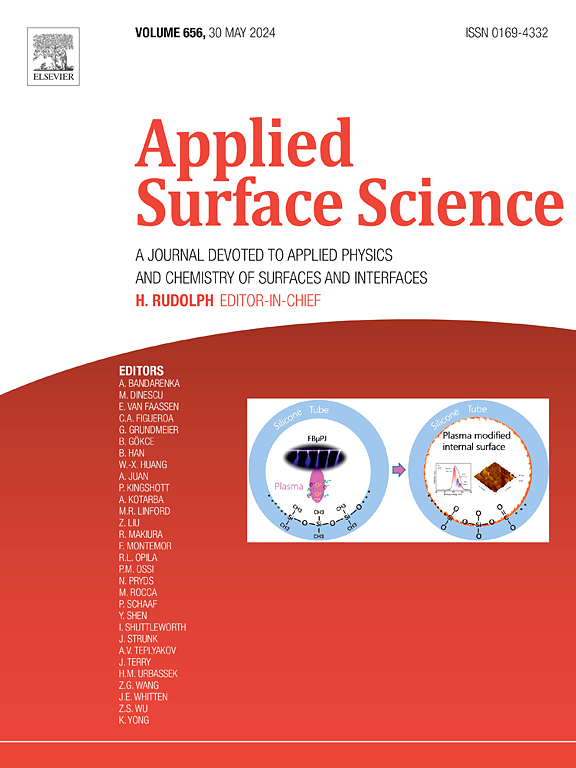Enhanced adsorption and detection of luteolin based on Fe/Zn bimetallic ZIF-derived Fe-Fe3O4 nitrogen-doped mesoporous carbon in-situ grown on carbon nanofibers
IF 6.3
2区 材料科学
Q2 CHEMISTRY, PHYSICAL
引用次数: 0
Abstract
As a natural flavonoid compound found in fruits, vegetables and herbs, luteolin (LU) has potent pharmacological activities and beneficial biological properties. Here, a Fe/Zn bimetallic ZIF pyrolysis-derived Fe-Fe3O4 N-doped mesoporous carbon was in-situ grown on carbon nanofibers (Fe-Fe3O4-NPC@CNFs), and it was used as an ultrasensitive electrochemical sensing platform for the efficient detection of LU in natural samples. Multiple characterization results show that Fe-Fe3O4-NPC@CNFs is a dodecahedral particle uniformly grown on CNFs with good crystal structure and uniform elemental distribution. Its rough surface with good mesoporous structure and high specific surface area of 823.19 m2/g is beneficial for LU adsorption. The density of states (DOS) and adsorption energies of NPC and Fe-Fe3O4-NPC further demonstrate that Fe-Fe3O4-NPC has better electrochemical performance and adsorption effect on LU. Under optimized conditions (carbonization: 800 ℃, pH: 5.0, enrichment: −0.2 V for 400 s), the Fe-Fe3O4-NPC@CNFs/GCE sensor showed satisfactory detection performance for LU in the range of 0.001–––1.5 μM with the limit of detection (LOD) of 0.47 nM. Furthermore, this sensor exhibits excellent anti-interference capability, reproducibility, and stability, and it was also possible to effectively detect LU in food samples. This work provides a new strategy for the quantitative analysis of LU in food.

纳米碳纤维上Fe/Zn双金属zif衍生Fe- fe3o4氮掺杂介孔碳对木犀草素的吸附和检测
木犀草素是一种存在于水果、蔬菜和草药中的天然类黄酮化合物,具有强大的药理活性和有益的生物学特性。本文在纳米碳纤维(Fe-Fe3O4-NPC@CNFs)上原位生长了Fe/Zn双金属ZIF热解衍生的Fe- fe3o4 n掺杂介孔碳,并将其作为超灵敏的电化学传感平台,用于高效检测天然样品中的LU。多重表征结果表明Fe-Fe3O4-NPC@CNFs是一种在CNFs上均匀生长的十二面体粒子,具有良好的晶体结构和均匀的元素分布。其表面粗糙,介孔结构良好,比表面积高达823.19 m2/g,有利于吸附LU。NPC和Fe-Fe3O4-NPC的态密度(DOS)和吸附能进一步表明Fe-Fe3O4-NPC具有更好的电化学性能和对LU的吸附效果。在优化条件下(炭化温度为800℃,pH为5.0,富集浓度为−0.2 V,富集时间为400 s), Fe-Fe3O4-NPC@CNFs/GCE传感器在0.001 ~ 1.5 μM范围内具有良好的检测性能,检出限为0.47 nM。此外,该传感器具有良好的抗干扰能力、重现性和稳定性,也可以有效地检测食品样品中的LU。本研究为食品中LU的定量分析提供了新的思路。
本文章由计算机程序翻译,如有差异,请以英文原文为准。
求助全文
约1分钟内获得全文
求助全文
来源期刊

Applied Surface Science
工程技术-材料科学:膜
CiteScore
12.50
自引率
7.50%
发文量
3393
审稿时长
67 days
期刊介绍:
Applied Surface Science covers topics contributing to a better understanding of surfaces, interfaces, nanostructures and their applications. The journal is concerned with scientific research on the atomic and molecular level of material properties determined with specific surface analytical techniques and/or computational methods, as well as the processing of such structures.
 求助内容:
求助内容: 应助结果提醒方式:
应助结果提醒方式:


